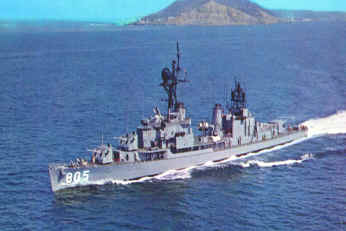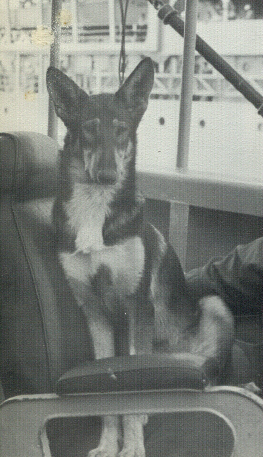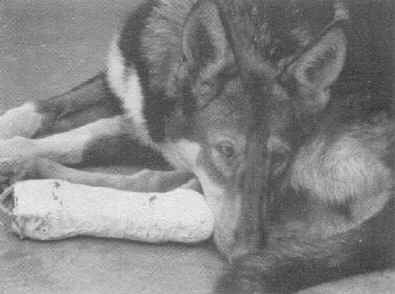|

The Adventures of SEAMAN CINDY
By Richard H. King, CDR USNR-Ret.
At the time of this story, CDR King was LT JG, Main Propulsion
Assistant (1965-1968),
(Assistant Engineering Officer for Main Propulsion)
U.S.S. CHEVALIER (DD-805)
 On July 14, 1967, the USS CHEVALIER DD-805 pulled into Victoria, British
Columbia, as part of a five ship American delegation to help celebrate the
Canadian Naval Centennial, and simultaneously, the British Columbia Centennial.
We were greeted warmly upon our arrival, with almost as much enthusiasm as when
we finally departed, about a week later. But that's another story. Sometime
during our tumultuous fun filled stay, one or more of the
boatswain's mates smuggled a small puppy on board and hid her in the boatswain's
locker.
On July 14, 1967, the USS CHEVALIER DD-805 pulled into Victoria, British
Columbia, as part of a five ship American delegation to help celebrate the
Canadian Naval Centennial, and simultaneously, the British Columbia Centennial.
We were greeted warmly upon our arrival, with almost as much enthusiasm as when
we finally departed, about a week later. But that's another story. Sometime
during our tumultuous fun filled stay, one or more of the
boatswain's mates smuggled a small puppy on board and hid her in the boatswain's
locker.
By the time we were almost back to San Diego, the only
person on board unaware of the stowaway was the Captain, G. G. Ely Kirk.
The X.O. finally gave the boatswain's mates an ultimatum. Tell the Captain. A
small delegation of boatswain's mates approached the Captain on the bridge,
confessed what they had done and asked the Captain for permission to keep the
puppy on board as the ship's mascot. The Captain sat there for a minute and then
said "well, how can I make a decision until I have seen the dog?
Smiles broke out everywhere.
The puppy was rushed to the bridge, and apparently she passed inspection
because she was enlisted on the spot for a one-year tour, including the 1967/68
deployment. The dog was named
"Cindy" (which coincidentally was the name of the Captain's
teen-aged daughter), given the rank of Seaman Apprentice and
assigned to First Division.
SA Cindy adjusted bit by bit to life on a destroyer and
became a very popular shipmate. For most sailors, billets on the "Watch, Station and
Quarters Bill" were handed down from on high. But for Cindy, she sort of
found her own. Take for example her General Quarters station. Part of the
training workup for a West Pac Deployment were gunnery drills. On the day of the
first gunnery exercise after Cindy came on board, she was frolicking around the
main deck. General Quarters was sounded, everyone rushed to their GQ Station,
Condition Zebra was set (all doors and hatches shut tight) and in the process,
Cindy was just plain overlooked and left out on deck.
shipmate. For most sailors, billets on the "Watch, Station and
Quarters Bill" were handed down from on high. But for Cindy, she sort of
found her own. Take for example her General Quarters station. Part of the
training workup for a West Pac Deployment were gunnery drills. On the day of the
first gunnery exercise after Cindy came on board, she was frolicking around the
main deck. General Quarters was sounded, everyone rushed to their GQ Station,
Condition Zebra was set (all doors and hatches shut tight) and in the process,
Cindy was just plain overlooked and left out on deck.
Mount 51, on the focsle, was the first mount to fire, and when the pair
of 5" guns went off, SA Cindy was directly under the gun
barrels. She bounced about three feet in the air,
and then took off running aft. She arrived on the fantail under Mount 53 just as
it too fired. Her plight, however, had been observed by the bridge watch and the
lookouts and orders were given to break Condition Zebra and let her into the
deckhouse. She
proceeded immediately to Damage Control Central (Engineering Log Room), almost
exactly in between the forward and after gun mounts, and curled up at the feet
of the phone talkers. From
that day forward, whenever GQ was sounded, Cindy would race on her own to Damage
Control Central and remain there patiently until "Secure from GQ” was
sounded.
 As time went on, Cindy found her place on other Watch
Bills. For the Special Sea and Anchor Detail, entering or leaving port,
she stood "Forward Lookout", with her nose sticking out through the
bull nose (the ring at the very tip of the bow through which a tow rope or
mooring hawser could be passed). In port, she spent most of her waking hours
standing "quarterdeck" watch at the brow (gang plank).
Seaman Cindy (she had by now been promoted) never mastered ladders, so
she stood watch, ate, slept and hung out on the main deck, both inboard and
outboard. By the time CHEVALIER arrived in Olongopo, Philippines, Seaman Cindy
knew every member of the crew, about 270 total, and would vigorously
"challenge" any non-crewmember coming up CHEVALIER's brow.
As time went on, Cindy found her place on other Watch
Bills. For the Special Sea and Anchor Detail, entering or leaving port,
she stood "Forward Lookout", with her nose sticking out through the
bull nose (the ring at the very tip of the bow through which a tow rope or
mooring hawser could be passed). In port, she spent most of her waking hours
standing "quarterdeck" watch at the brow (gang plank).
Seaman Cindy (she had by now been promoted) never mastered ladders, so
she stood watch, ate, slept and hung out on the main deck, both inboard and
outboard. By the time CHEVALIER arrived in Olongopo, Philippines, Seaman Cindy
knew every member of the crew, about 270 total, and would vigorously
"challenge" any non-crewmember coming up CHEVALIER's brow.
During our short first stay in Olongopo, the Subic Bay
SRF (Ship Repair Facility) was doing an emergency overnight job in the forward
fireroom replacing the No. 1 boiler main steam outlet elbow.
It was a critical and important job because that boiler constituted a
quarter of our propulsion capability and we were supposed to leave in the
morning for Vietnam. While enjoying a few gin and tonics at the "0"
Club on base, knowing they would be the last gin and tonics I would have for a
long time, I received a phone call from the duty engineer. I was told that the
Ship Repair Facility "yard birds" (civilian workers) working on the
boiler had gone on strike and were sitting on the pier. They
refused to go back to work until we got rid of "that vicious guard
dog". I
rushed back to the ship and locked Cindy up in the air-conditioned electronics
workshop. After some persuasion and assurances, the Philippino workers went back
to work and the CHEVALIER got underway in the morning, with the last of the
workers having to climb over the rail to the pier because the brow had already
been removed.
Sometime in October of 1967, while CHEVALIER was engaged in Naval
Gunfire Support for army and marine units ashore in Vietnam, Seaman
Cindy hurt her leg and was put on the "binnacle list" (too sick or
injured to carry out her duties). A few days later, when CHEVY steamed into Kaohsiung,
Taiwan for a "TAV" (tender availability period), there was an
"Arrival Conference" in the wardroom.
Work Requests were reviewed and approved or rejected. At some point
during the conference, the captain of the tender remarked that he had excellent
medical and dental facilities.
Captain Kirk replied that he had "one sailor needing
attention", but didn't explain it any further.
and was put on the "binnacle list" (too sick or
injured to carry out her duties). A few days later, when CHEVY steamed into Kaohsiung,
Taiwan for a "TAV" (tender availability period), there was an
"Arrival Conference" in the wardroom.
Work Requests were reviewed and approved or rejected. At some point
during the conference, the captain of the tender remarked that he had excellent
medical and dental facilities.
Captain Kirk replied that he had "one sailor needing
attention", but didn't explain it any further.
Thirty minutes
after the conference
concluded, however, Seaman Cindy was in the tender's sickbay,
much to the surprise of the doctor and corpsmen. The doctor took an x-ray and
concluded that Cindy had a broken leg. The fracture was set and a plaster cast
with an aluminum tip was applied. The story of Seaman Cindy's treatment was put
into the tender's P.O.D. (Plan of the Day) as a news item, and before the T.A.V.
was cut short by an approaching typhoon, the tender delivered to CHEVY a
beautiful wood dog bed, stained, varnished and upholstered, with suction cups on
the bottom to grip the deck in heavy weather and an engraved nameplate on the
side. The bed was placed in the after athwartships passageway opposite the
ship's store. Cindy took to it
without hesitation, obviously liked it and in time recovered completely.
The amazing thing about the tender's gift was that no Work Request (Form
OPNAV 4700-2C) was ever submitted in triplicate and approved in
quadruplicate to "fabricate dog bed for medium sized dog". Cindy's
bed was the only tender job I can remember which was completed without a
duly prepared and signed OPNAV 4700-2C.
|
|
|
 Captain
Kirk and Seaman Cindy got along well
despite their disparity in rank. Kirk took her ashore with him on
several occasions I can remember including the ship's party on Grande Isle
in Subic and again in Australia to a Cricket Match! Captain
Kirk and Seaman Cindy got along well
despite their disparity in rank. Kirk took her ashore with him on
several occasions I can remember including the ship's party on Grande Isle
in Subic and again in Australia to a Cricket Match!
|
|
|
Captain Kirk, through his influence in high
places, had managed to retain command of CHEVALIER for almost three years,
a year longer than the normal Bureau of Personnel pattern of rotation. At the
very end of this deployment, we headed for Brisbane, Australia. Just before
departing for Brisbane, however, Captain Kirk's relief came on board. While the
outgoing captain and the soon to be new captain went through the turnover
process, we crossed the equator and had to go through the proper "crossing
the line" ceremonies. In these ceremonies, "shell backs" (sailors
who have crossed the equator before) initiate "polliwogs" (sailors
crossing for the first time).
Seaman Cindy, of course, was a "polliwog" and had to go through
the same gauntlets as her lowly peers, including a crawl through "the
garbage chute" and "kissing the belly of the Royal Baby". At the
end of the ceremonies, everyone was issued about three beers each. This was even
more illegal than having a dog on board, and the soon to be new Captain just had
to take it all in. Change of Command ceremonies were held while we were in
Brisbane and Captain Kirk flew home to the states.
Upon returning to San Diego, I overheard the new captain, CDR
Glen Palatini, tell the X.O. that although Seaman Cindy seemed to be a good
sailor, very popular with the crew, the X.O. needed to start looking for
a way to "transfer" her off the ship in a manner, which would not hurt
morale. A few weeks thereafter, while
CHEVY was tied to pier six in San Diego, liberty call was sounded and everyone
not in the duty section rushed down the brow at 32 knots, including the captain,
the X.O. and all department heads.
I was C.D.O. of the duty section and about a half hour later, I was just
standing on the fantail exchanging scuttlebutt with other sailors who also had
the duty. As usual, Seaman Cindy was hanging out in the same general area where
she could keep an eye on the brow.
 Someone
noticed a gray official Navy sedan coming down the pier, sporting a pennant on
the fender with two stars on it, and called it to my attention. Since
no official "flag visit" was expected, and since we were opposite the
pier from a new DLG (guided missile destroyer leader, about twice CHEVY's size),
I assumed the Admiral's destination was the DLG. "ASSUME" is a Navy
acronym for “makes an ass of you and me". Someone
noticed a gray official Navy sedan coming down the pier, sporting a pennant on
the fender with two stars on it, and called it to my attention. Since
no official "flag visit" was expected, and since we were opposite the
pier from a new DLG (guided missile destroyer leader, about twice CHEVY's size),
I assumed the Admiral's destination was the DLG. "ASSUME" is a Navy
acronym for “makes an ass of you and me".
The car stopped midway between the two ships, an aide jumped out, opened the
rear door on the CHEVALIER side, and out bounced an Admiral who
then headed straight for our brow! OH SHIT!
I risked the guess that this was our flotilla commander, although I had
never met or even seen him,
and told the watch to bong him aboard as such. Even as sweat was forming under
my cover (hat), by the time the Admiral was halfway up the brow, I suddenly had
a new problem. Seaman Cindy couldn't tell the difference between an admiral and
a seaman recruit and in her mind, he was just an intruder! Accordingly, she went
into her "Alarm Model' and began barking louder than I had ever heard
before.
As the somewhat startled Admiral saluted the national
ensign, I grabbed Cindy's collar with my left hand and a few seconds
later rendered one of the most memorable salutes that admiral ever received,
holding Cindy by her collar and therefore in a very crooked version of
attention. Then the Admiral asked, "Is this part of the
ship's security program?" My reply was "Yes Sir! She knows
every member of the crew and alerts the watch if a non-crew member is coming
aboard."
Thankfully, Cindy had stopped barking and her tail was now
wagging. The admiral bent over and petted Seaman Cindy while asking first if the
Captain was on board, and then if the X.O. was on board. After learning
that neither were on board, the Admiral told me "Tell the Captain I dropped
by", turned around and departed as quickly as he had arrived. In the
morning, I duly reported the surprise flag visit, but left out the part
concerning Cindy's greeting.
Seaman Cindy was the "best friend" of every
member of the crew, but to her, some of her "best friends" were
better than others. At the very top of her list were the ship's cooks who
prepared and served her meals just inside the galley door. Shortly after the
"Admiral incident", the X.O. learned that one of the cooks was going
to retire. Then he found out that the cook was going to retire to a family farm
in northern California. After a brief conference between the cook and the X.O.,
it was quickly agreed that there would be a double retirement ceremony, much to
the X.O.'s relief.
When the big day came, there were the requisite six side boys in full dress
white and a boatswain's mate with his boson’s pipe. Although it was a
Saturday, a large crowd gathered on the fantail, including the X.O. The cook
went down the brow first, to the traditional "pipe" and announcement. A
moment later, the "pipe" was repeated, "Seaman Cindy, United
States Navy Retired, departing" was announced over the loudspeakers and
Cindy was led down the brow to the car belonging to the cook's family.
Her service in the United States Navy was thereby honorably completed and
so far as was known, she lived happily ever after.

A Final Note from CDR King:
I fell in love with Seaman Cindy (initially Seaman
Apprentice Cindy) the first time I saw her. But after she was enlisted, how
was this going to work? The Boatswain Mates were supposed to take care of
her, but they did not do a good job. I was in Engineering Dept, a
very junior "O" but somehow I found time to address the problem.
First thing was toilet training. Under normal situations, a puppy is first
taught to use newspapers. Later they are taught to go outside (but there
is no "outside" on a destroyer at sea). My theory was we needed
to paper train Cindy on newspaper and never go to the next step. I found
an obscure spot on the main deck inboard and the training began. The
Ship's Cooks on the other hand did a good job. All the food she needed but
not too much and served at regular times each day. Also, care to avoid too
much fat.

 

|

 Someone
noticed a gray official Navy sedan coming down the pier, sporting a pennant on
the fender with two stars on it, and called it to my attention. Since
no official "flag visit" was expected, and since we were opposite the
pier from a new DLG (guided missile destroyer leader, about twice CHEVY's size),
I assumed the Admiral's destination was the DLG. "ASSUME" is a Navy
acronym for “makes an ass of you and me".
Someone
noticed a gray official Navy sedan coming down the pier, sporting a pennant on
the fender with two stars on it, and called it to my attention. Since
no official "flag visit" was expected, and since we were opposite the
pier from a new DLG (guided missile destroyer leader, about twice CHEVY's size),
I assumed the Admiral's destination was the DLG. "ASSUME" is a Navy
acronym for “makes an ass of you and me". ![]()
![]()
![]()